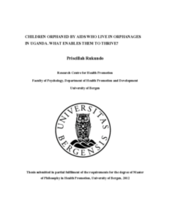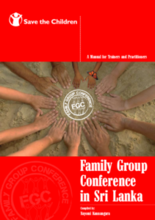Displaying 1291 - 1300 of 1508
The Deinstitutionalization Toolkit is designed to provide all those interested in institutional closures and expanded community living opportunities for people with intellectual disabilities and developmental disabilities (ID/DD) with information, strategies, state data, and case studies that can facilitate closure and build community capacity to serve more people with ID/DD in the community. It covers topics such as building a broad-based coalition, understanding and working within the political environment, creating a community system of care, and relevant laws, policies, and court decisions.
This study aimed at finding out what enables children orphaned by AIDS who live in orphanages to thrive.
This article provides an update on a series of projects that have highlighted the issue of institutionalization of children in Europe, arguing that babies and small children aged less than 3 years old, with or without disability, should not be placed in residential care without a parent or primary caregiver.
This manual, produced by Save the Children in Sri Lanka, provides guidance on Family Group Conferencing (FGC), which was introduced to the governmental childcare structure in Sri Lanka's Southern Providnce between 2006-2008. Th
Attachment has been assessed in the extreme environment of orphanages, but an important issue to be addressed in this chapter of Monographs of the Society for Research in Child Development Volume 76, Issue 4 is whether in addition to standard assessment procedures, such as the Strange Situation, the lack of a specific attachment in some institutionalized children should be taken into account given the limits to the development of stable relationships in institutionalized care.
Utilizing the United Nations Convention on the Rights of the Child and the Guidelines for the Alternative Care of Children, this paper from Monographs of the Society for Research in Child Development Volume 76, Issue 4 examines critical components and current characteristics of alternative care for children in low‐resource countries.
Children within institutional care settings experience significant global growth suppression, which is more profound in children with a higher baseline risk of growth impairment (e.g., low birth weight [LBW] infants and children exposed to alcohol in utero), according to this chapter from Monographs of the Society for Research in Child Development Volume 76, Issue 4.
This monograph reviews literature pertaining to children without permanent parents.
This paper from Monographs of the Society for Research in Child Development Volume 76, Issue 4 proposes a number of key components for translating research into policy and programs: analyzing the situation, using evidence to build the case for action, developing policies, building program capacity in child welfare and early childhood development, creating a family‐based child welfare system, and developing a system of monitoring and accountability.
This chapter from Monographs of the Society for Research in Child Development Volume 76, Issue 4 reviews the neurobiological literature on early institutionalization that may account for the psychological and neurological sequelae discussed in other chapters in this volume.


